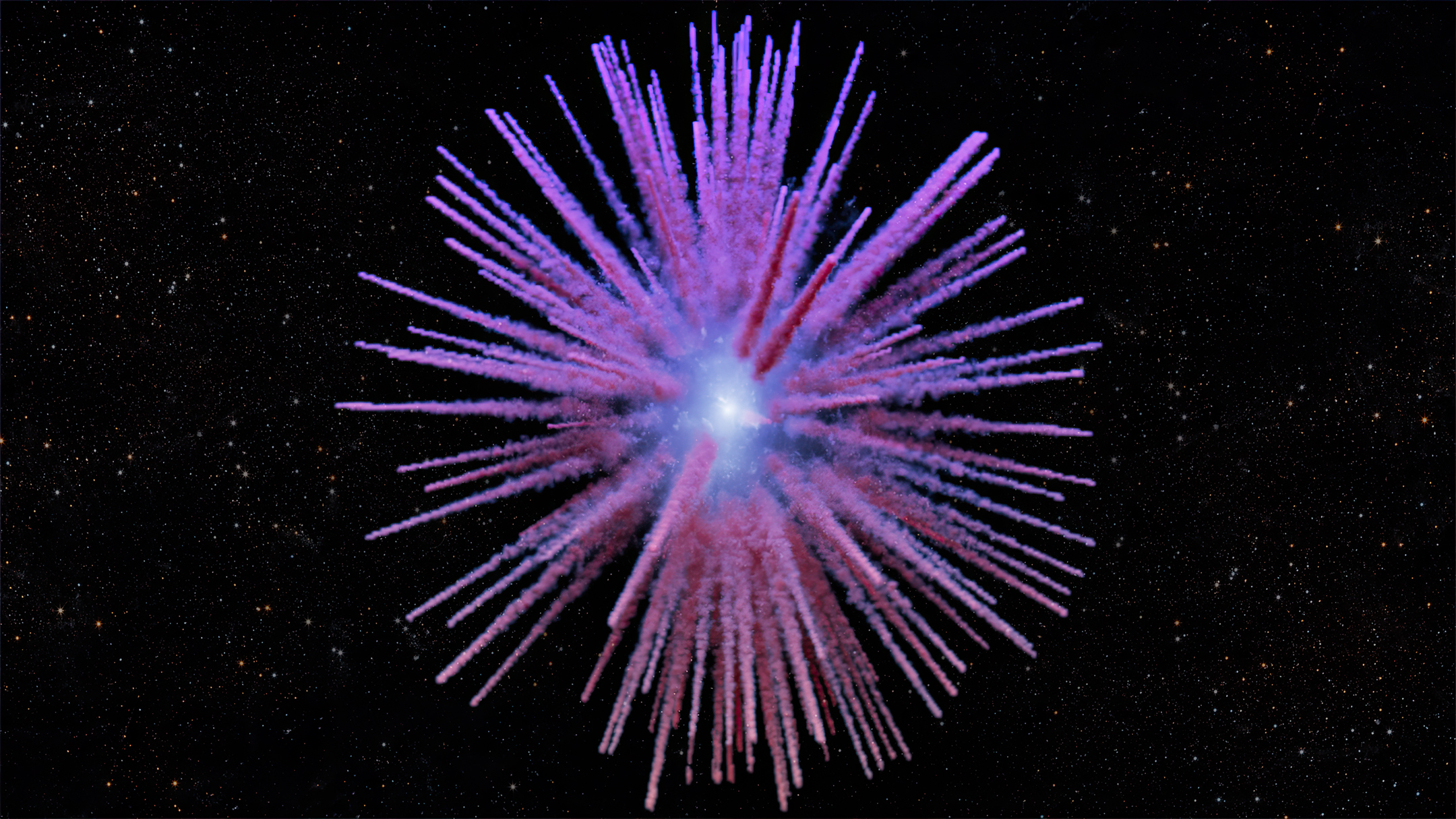28.10.2024

Maunakea, Hawaiʻi – For nearly six months during the year 1181, people looked up to the skies to find a new star glittering in the constellation Cassiopeia. Chinese and Japanese astronomers recorded the rare event, an explosion of a star, or supernova. In the centuries since, astronomers have searched for the remains of the blast, but it was not until 2013 that they were finally found. As part of a citizen scientist project, amateur astronomer Dana Patchick—who had sifted through images taken by the now-retired Wide-field Infrared Survey Explorer, or WISE—found a nebula at the site where the supernova had occurred.
Further observations convinced astronomers that this nebula, called Pa 30, was in fact the leftover ejected material from the 1181 supernova. Later, in 2023, astronomers discovered strange filaments within the supernova remnant, which resemble the wispy tendrils of a dandelion flower.
Now, with the help of the Caltech-built Keck Cosmic Web Imager (KCWI) at the W. M. Keck Observatory on Maunakea, Hawai‘i Island, astronomers have, for the first time, mapped the location of those unusual filaments in three dimensions in addition to the speed at which they are streaming outward from the site of the blast.
“A standard image of the supernova remnant would be like a static photo of a fireworks display,” says Caltech professor of physics Christopher Martin, who led the team that built KCWI. “KCWI gives us something more like a ‘movie’ since we can measure the motion of the explosion’s embers as they streak outward from the central explosion.”
Martin is a co-author of a new paper reporting the findings published today in The Astrophysical Journal Letters. The study is led by Tim Cunningham, a NASA Hubble Fellow at the Center for Astrophysics |Harvard & Smithsonian (CfA), and the co-lead author is Ilaria Caiazzo, a former Caltech postdoctoral scholar who recently became an assistant professor at the Institute of Science and Technology Austria.
In 1181, astronomers in China and Japan recorded a new star in the sky, a rare supernova explosion. The remains of that supernova, called SN 1181, are depicted here in this artist’s animation, which flies around the remnant as it appears today in one moment in time. The corpse of the star that detonated, a hot and inflated “zombie” star, is seen within a dusty shell of ejected material. Beyond the dusty shell, bright radial filaments of sulfur extend three light-years out from their point of origin. The Keck Cosmic Web Imager (KCWI) at the W. M. Keck Observatory has mapped these filaments in 3-D and shown that they are flying outward at approximately 1,000 kilometers per second. Credit: W. M. Keck Observatory/Adam Makarenko
The 1181 supernova is thought to have occurred when a thermonuclear explosion was triggered on a dense dead star called a white dwarf. Typically, the white dwarf would be completely destroyed in this type of explosion, but in this case some of the star survived, leaving behind a sort of “zombie star.” This type of partial explosion is called a Type Iax supernova. “Because this was a failed explosion, it was fainter than normal supernovae, which has been shown to be consistent with the historical records,” Caiazzo says.
Material ejected in the 1181 explosion makes up the Pa 30 nebula that astronomers observe today. While the scientists know that the peculiar filaments, which glow with light from sulfur, were also generated by the supernova, they do not know how and when they formed.
To probe the three-dimensional structure of the supernova remnant, the astronomers turned to KCWI, an instrument that can capture multiwavelength, or spectral, information for every pixel in an image. This is like breaking apart the light captured in every pixel into a rainbow of colors. The spectral information enabled the team to measure the motions of the filaments poking out from the center of the explosion and ultimately create a 3D map of the structure. The filament material that is flying toward us shifted toward the blue higher-energy portion end of the visible spectrum (blue-shifted), while light from material moving away from us shifted toward the red end of the spectrum (red-shifted).
This is analogous to the Doppler shift one can hear as a blaring firetruck races by. As the vehicle moves toward us, the sound waves from its horn become squeezed into higher frequencies; as the truck moves away from us, the sound waves become elongated to lower frequencies.
Specifically, this study used the “red arm” of the KCWI instrument, which was installed at Keck Observatory last summer. KCWI consists of two halves: One captures light wavelengths at the blue end of the visible spectrum, and the other half covers the red end in addition to infrared light. “The addition of the red arm more than doubled the spectral coverage of KCWI and made these observations possible,” says Caltech graduate student and co-author Nikolaus Prusinski. “This 3D map comprises the most sensitive spatial and spectral measurements of Pa 30 to date and holds the current record for the largest contiguous region surveyed with the red channel.”
The results showed that the filament material in the supernova is flying outward from the site of the explosion at approximately 1,000 kilometers per second.
“We find the material in the filaments is expanding ballistically,” says Cunningham. “This means that the material has not been slowed down nor sped up since the explosion. From the measured velocities, looking back in time, you can pinpoint the explosion to almost exactly the year 1181.”
The 3D information also revealed a large cavity inside the spindly, spherical structure in addition to some evidence that the supernova explosion of 1181 occurred asymmetrically.
As to how the filaments formed after the blast, the scientists are still puzzled. “A reverse shock wave may be condensing surrounding dust into filaments, but we don’t know yet,” says Cunningham. “The morphology of this object is very strange and fascinating.”
Quelle: W. M. Keck Observatory
